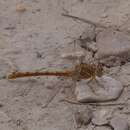Biology
provided by Arkive
Odonata species start their life as aquatic larvae, passing through a series of developmental stages or 'stadia' and undergoing several moults as they grow. Before the final moult (emergence), metamorphosis occurs in which the larvae transform into the adult form. Adults complete their metamorphosis after emergence and undergo a pre-reproductive phase known as the maturation period, when individuals normally develop their full adult colour (4).
Although the biology of the faded pincertail remains mostly unstudied, certain details can be inferred from what is known about other pincertails in the same habitats and climatic areas. Eggs should hatch three to four weeks after deposition and the larval period should spread over two to three years, passing through 13 to 15 stadia. The larvae hunt hidden within the sand or leaf litter detritus at the surface of the sediments. Emergence is rapid, and the adult flight period for the faded pincertail lasts from May to August (2).
Faded pincertails do not defend territories and is easily observed on the ground, on stones in the middle of rivers, or perched in the vegetation. Aggressiveness between males seems to remain rather low in this species, unlike in other pincertails. Females lay eggs alone, not being guarded by their mate, touching water by the tip of their abdomen during a typical confused flight, so that eggs will detach easily and fall to the bottom of the river, where a mucus envelope fixes them to the substrate.
Adult Odonata feed on flying insects and are often generalised, opportunistic feeders, sometimes congregating around abundant prey sources such as swarms of other insects (4).
Conservation
provided by Arkive
There are currently no conservation measures targeting this species (1).
Description
provided by Arkive
As its common name suggests, this species possesses more subdued colours than most of its pincertail (Onychogomphus spp.) relatives, being mostly sandy brown.
Habitat
provided by Arkive
The faded pincertail reproduces only in running waters such as brooks and rivers of various sizes, exceptionally up to 2,000 metres above sea level in Morocco (3).
Range
provided by Arkive
Known from North Africa (Algeria, Morocco, Tunisia) and the Iberian Peninsula (Spain and Portugal) (1).
Status
provided by Arkive
Classified as Vulnerable (VU) on the IUCN Red List 2007 (1).
Threats
provided by Arkive
Populations of the faded pincertail have decreased over recent years as a result of pollution degrading essential habitat, and irrigation and excessive water extraction for human use leading to the drying up of streams and rivers. This pattern of decline is expected to continue, particularly due to the increasing frequency and severity of summer droughts in the Mediterranean area, and human population expansion in northern Africa, leading to a growing water demand and increased levels of pollution (1).
Onychogomphus costae: Brief Summary
provided by wikipedia EN
Onychogomphus costae is a species of dragonfly in the family Gomphidae. It is found in Algeria, Morocco, Portugal, Spain, and Tunisia. Its natural habitat is rivers. It is threatened by habitat loss.
- license
- cc-by-sa-3.0
- copyright
- Wikipedia authors and editors

